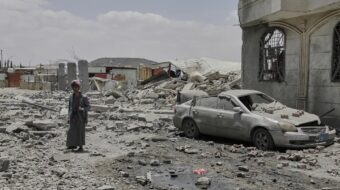As the war in Iraq entered its third week, reports of casualties show the mounting physical and psychological toll on the Iraqi people and on U.S. soldiers as well.
Some 725 civilian Iraqi deaths were reported as the United States dropped 8,000 bombs on Iraqi cities in 13 days of war. By April 2, the toll of U.S. casualties was 46 killed, 7 captured and 16 missing. Figures on Iraqi military casualties are not available.
The Pentagon claims that civilian casualties are “unavoidable.” Stephen Zunes, a Middle East expert at the University of San Francisco, called this claim “patently false,” saying, “Civilian casualties are unavoidable only if the war is unavoidable. This war was not unavoidable.”
U.S. missiles hit a Red Crescent maternity hospital and other civilian buildings in Baghdad, killing several people and wounding at least 25 residents and three Red Crescent staff, including a doctor. A patient was also hit, requiring his leg to be amputated. Burned-out and twisted cars lay in the road, their occupants burned to death inside.
Fifteen members of a family were killed when their pickup truck was blown up by a rocket from a U.S. helicopter near Hilla, a farming town south of Baghdad. The sole survivor said he lost his wife, six children, his father, his mother, three brothers and their wives. Sitting among the 15 coffins at the local hospital, he said the family was fleeing fighting further south when they were attacked.
Wounded children lay under blankets on the hospital floor due to a shortage of beds. Dozens of homes were destroyed in the bombing, and parts of cluster bombs were scattered over a large area.
Earlier, U.S. troops killed 11 Iraqis, mostly women and children, when the soldiers fired on a civilian vehicle at a military checkpoint near the southern city of Najaf. Fifteen Iraqis were packed inside the van with their possessions. Ten, including five small children, were killed on the spot when high-explosive rounds slammed into them. One died later from severe injuries. “You just f… killed a family because you didn’t fire a warning shot soon enough!” a U.S. captain reportedly yelled at his troops.
“It was the most horrible thing I’ve ever seen, and I hope I never see it again,” a 26-year-old Army medic told a reporter. He said one of the wounded women sat in the vehicle holding the mangled bodies of two of her children. “She didn’t want to get out of the car,” he said.
Reporters described the soldiers as having been on edge since four American troops were blown up by a suicide bomber two days earlier at a similar checkpoint just 20 miles away.
U.S. peace activists visiting a town in Iraq’s western desert March 30 found its hospital destroyed by bombs.
“Why? Why?” a doctor demanded of them. “Why did you Americans bomb our children’s hospital?”
Thus far 65 to 100 civilian casualties have been reported in the southern city of Basra, where the U.S. air assault has included use of cluster bombs. A resident asked a reporter, “Why are they killing our children? We are innocent. The children are scared.”
Damage to the electric power grid shut Basra’s water-treatment plant immediately after the ground war started. Most of Basra’s 1.5 million people had no access to safe water for several days. After a week, only half the city had service restored. United Nations officials fear repeats of this crisis in Baghdad and other cities under attack. They warn of potential outbreaks of diarrhea, cholera and other potentially fatal diseases that will hit children and the elderly particularly hard.
Despite punishing U.S. and British artillery and aerial bombing, British troops have failed to capture Basra. Dismissing earlier British claims that citizens were rebelling against Saddam Hussein’s government, a resident told the Washington Post, “There’s been absolutely no uprising.”
Human Rights Watch (HRW) assailed the U.S. use of cluster bombs and grenades. Cluster weapons have a very high failure rate that creates immediate and long-term dangers for civilians and soldiers, HRW said. When such munitions fail to explode on impact, they become like volatile, indiscriminate anti-personnel landmines, the group said.
HRW said it is evident from television images and stories from reporters “embedded” with U.S. units that artillery projectiles and rockets containing large numbers of cluster munitions are being used. These weapons have failure rates close to one in five.
“The United States should not be using these weapons,” said Steve Goose, executive director of HRW’s arms division. “Iraqi civilians will be paying the price with their lives and limbs for many years.”
The author can be reached at suewebb@pww.org
PDF version of ‘War in Iraq takes horrifying toll’










